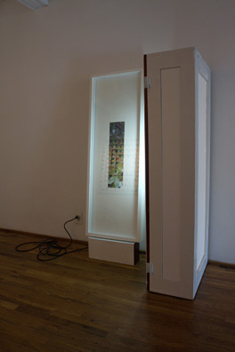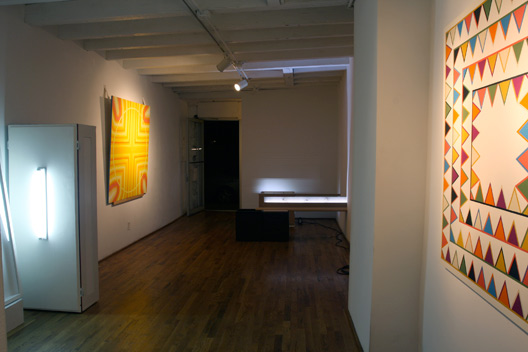Lateralisms
The Hogar Collection
July 9 – August 8, 2010
Dike Blair, James Woodfill, Stephen Westfall and Ben Dowell
Curated by Matt Wycoff








In his essay, Art and Objecthood, Michael Fried famously decried minimalism for its theatricality. In Fried’s view the minimalist object was little more than the situation it composed. It is in this sense that Fried spoke of minimalism’s “hollowness” – its lack of self-sufficiency and autonomy from the everyday world. Art’s contingence on the viewer, history and site continues to resonate amid dialogues concerning interconnection and interdependence that globalization and postmodernism have made sometimes painfully, sometimes redundantly, apparent. Lateralisms represents two generations of artists closely tied to the decisive contingency of minimalism, and to its redrawing of the parameters around both the artwork and the self/artist.
For over twenty-five years Dike Blair and James Woodfill and have engaged the minimalist project through the language of sculptural installation. While installation art – from Kurt Schwitters, “Merzbau” to the installations of Jason Rhodes and Thomas Hirschhorn – pushes towards surrealism, Blair and Woodfill’s works tend toward retaining their objecthood, holding the paradoxes of their autonomy as singular artworks in tension. Dike Blair’s sculptural installations often treat painterly notions of luminosity and surface sculpturally, while intimations of the body appear in small, finely crafted paintings set within human-scaled geometries. Blair’s stripped-down, carefully composed situations seduce the viewer into conversations concerning design, nature and individuality. While remaining rooted in the object, James Woodfill’s most recent installations, utilizing 2x4’s, plywood and casters, sometimes threaten to dissolve into the spaces where the wall meets the floor or along the geometries of conduit, gas pipe and duct work. Woodfill’s materiality is classically quotidian; his works, however, do not dwell unnecessarily on the differences between art and mere object, but coalesce in the drift between the two.
Woodfill and Blair each utilize the inevitability of reference in material relationships and histories to suggest strands of potential narrative content. But having shifted the exterior boundaries of their works from the edges of a painting, say, to the boundaries of a particular site or set of objects, their works also reclaim something of the autonomy, or self-involvement, of the modernist preoccupation with composition, color and form. This gesture suggests the possibilities of the contingent minimalist gesture to readdress painterly self-reference and autonomy.
In a similar paradoxical gesture, the paintings of Stephen Westfall and Ben Dowell move painting outside its literal boundaries (edges) and formal concerns, and onto site. Stephen Westfall’s paintings are representative of a critical continuance of abstract painting that has reformulated the practice into the contemporary moment. Westfall’s paintings utilize subtle reference to extend abstract painting’s concern outside its perceptual or formal consequences¬ alone and into a cobbled referential landscape. The use of reference is itself a tacit acknowledgement of the inevitability of metaphor in communication. Westfall initiates a dialogue whose interrogation of abstraction begins to align abstract painting with observation – with looking intently at the world. Ben Dowell’s paintings represent the next iteration of this impulse by saturating the painted object with its own history. Dowell’s paintings are literally laden, heavy with paint whose often day-glow color schemes seem to reverberate within what has recently been termed, “a feedback loop of infinite regress.” Dowell’s paintings are relational by way of their internal reference, but also by way of their very physicality. The result is that they seem to spill out of their borders, reframing the conditions of their specific site but also highlighting the ways in which histories accrue in the objects and spaces of our everyday lives.
The sedimentation and retention of histories found in Lateralisms alludes to a larger accumulation of histories. Whereas modern works purported a linear thrust focused on the new, the works represented here foreground return as a formal strategy. This process of return privileges equation more than differentiation, and is part of an ongoing shift in the meaning of art. This shift also marks a change in our understanding of the artist, and of individuality more broadly. But whereas deconstruction spoke of the death of the author, the changes marked by the minimalist object expanded the boundaries and contingencies of the artwork, individuality and authorship, while retaining something essentially modern. This “something” is what Fredric Jameson referred to as, “the metaphysics of inside and outside.” In other words, to express at all (to project something onto or into the world) presupposes a duality between interior and exterior. Fried’s critique itself alludes to this connection to modernism. By framing the minimalist object as “hollow” Fried implies the existence of some essential vessel or form, however compromised. In this sense, the genealogy of minimalism over the past forty years is that of a restrained optimism in the wake of modernism’s failed dogmatism, and diligence in response to the vague nihilisms of postmodernism – an acknowledgment of contingency, but a strong belief in a distinct practice of art. The subtle, ever more precise movements and shifts that characterize the work in Lateralisms are a kind of horizontal movement in many directions simultaneously. The results of this movement are artworks that seem more aware, closer to embodying the contradictions that enable them in the first place. This lateral movement across time and genre begins to account for how an installation and a painting may have come to mean the same thing; not in the sense of their most literal physicality, but in the demands they place on the viewer and the ways they interact with history and the physical world around them.
1 Jerry Saltz, “Reconstruction Zone,” The Village Voice (June 6, 2006)
2 Fredric Jameson, Postmodernism or, the Cultural Logic of Late Capitalism, (Durham, North Carolina: Duke University Press, 1991), 11